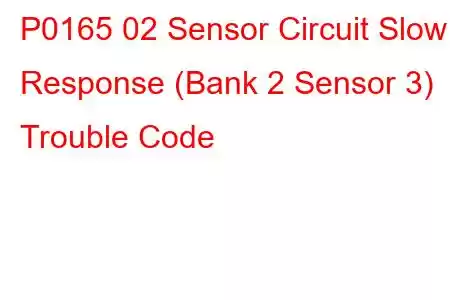P0165 O2 Sensor Circuit Slow Response B2S3
OBD-II Trouble Code Technical Description
O2 Sensor Circuit Slow Response (Bank 2 Sensor 3)
What does that mean?
This diagnostic trouble code (DTC) is a generic powertrain code, which means that it applies to all 1996-newer vehicles (Mitsubishi, Nissan, Volkswagen, Inifiniti, etc.). Although generic, the specific repair steps may vary depending on make/model.
If your OBD-II equipped vehicle has a stored P0165 code, it means that the powertrain control module (PCM) has detected a slow response time from a downstream (or post catalytic converter) oxygen (O2) sensor or circuit. Bank 2 denotes the bank of the engine that does not contain the number one cylinder and Sensor 3 indicates that the malfunction is related to the downstream sensor in a system equipped with only three sensors (as opposed to a four-sensor system).
O2 sensors are constructed using a zirconium dioxide sensing element which is protected by a vented steel housing. The sensing element is connected to wire leads in the O2 sensor wiring harness using platinum electrodes. The PCM is connected to the O2 sensor wiring harness using the controller area network (CAN). The PCM is supplied with data, pertaining to the percentage of oxygen particles in the engine exhaust as compared to the oxygen content of ambient air, by the O2 sensor.
Exhaust gases are pushed into the exhaust pipe and through the catalytic converter; afterward, they pass over the downstream O2 sensor. As exhaust flows through vent holes (in the steel housing) and across the sensing element, ambient air is drawn through the wire lead cavities and into a small chamber in the middle of the sensor. The ambient air (in the chamber) is heated by the exhaust, forcing the oxygen ions to produce (energy) voltage. Deviations between the number of oxygen molecules in ambient air (drawn into the O2 sensor) and the concentration of oxygen ions in the spent exhaust gases cause the voltage to change. These changes cause the oxygen ions inside the O2 sensor to jump between platinum layers very rapidly and repetitiously.
Voltage variations occur as the rushing oxygen ions jump between platinum layers. The PCM identifies these variations in voltage as changes in exhaust oxygen concentration. These changes indicate that the engine is either running lean (too little fuel) or rich (too much fuel). The voltage signal from the O2 sensor is low when more oxygen is present in the exhaust (lean condition) and high when less oxygen is present in the exhaust (rich condition). This data is used by the PCM primarily to monitor catalytic converter efficiency. If the downstream O2 sensor circuit fails to cycle as expected, over a set period of time and under certain programmed circumstances, a P0165 code will be stored and a malfunction indicator lamp may be illuminated.
Severity & Symptoms
Since a P0165 code means that the post catalytic converter O2 sensor has remained slow or unresponsive, it should be addressed at your earliest convenience.
Symptoms of a P0165 code may include:
A lack of general engine performance Diminished fuel efficiency Other related diagnostic trouble codes may also be stored Service engine soon lamp illuminationCauses
Possible causes for this engine code include:
Defective O2 sensor/s Burnt, broken, or disconnected wiring and/or connectors Clogged catalytic converter Engine exhaust leaksDiagnostic and Repair Procedures
A good starting point is always to check for technical service bulletins (TSB) for your particular vehicle. Your issue may be a known issue with a known fix put out by the manufacturer and can save you time and money during diagnosis.
A diagnostic scanner, digital volt ohmmeter (DVOM), and a reliable vehicle information source are tools that I would require when diagnosing a code P0165. <
Read: 45


